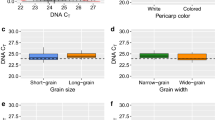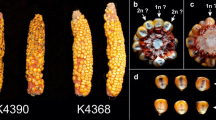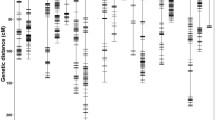Abstract
Leaf collection from the field, labeling and tracking back to the source plants after genotyping are rate limiting steps in leaf DNA-based genotyping. In this study, an optimized genotyping method using endosperm DNA sampled from single maize seeds was developed, which can be used to replace leaf DNA-based genotyping for both genetic studies and breeding applications. A similar approach is likely to be suitable for all plants with relatively large seeds. Part of the endosperm was excised from imbibed maize seeds and DNA extracted in 96-tube plates using individuals from eight F2 populations and seven inbreds. The quality of the resultant DNA was functionally comparable to DNA extracted from leaf tissue. Extraction from 30 mg of endosperm yields 3–10 μg DNA, which is sufficient for analysis of 200–400 agarose-gel PCR-based markers, with the potential for several million chip-based SNP marker analyses. By comparing endosperm DNA and leaf DNA for individuals from an F2 population, genotyping errors caused by pericarp contamination and hetero-fertilization were found to average 3.8 and 0.6%, respectively. Endosperm sampling did not affect germination rates under controlled conditions, although under normal field conditions the germination rate, seedling establishment, and growth vigor were significantly lower than that of non-sampled controls for some genotypes. However, careful field management can compensate for these effects. Seed DNA-based genotyping lowered costs by 24.6% compared to leaf DNA-based genotyping due to reduced field plantings and labor costs. A substantial advantage of this approach is that it can be used to select desirable genotypes before planting. As such it provides an opportunity for dramatic improvements in the efficiency and selective gain of breeding systems based on optimum combinations of marker-assisted selection and phenotypic selection within and between generations.








Similar content being viewed by others
References
Belicuas PR, Guimarães CT, Paiva LV, Duarte JM, Maluf WR, Paiva E (2007) Androgenetic haploids and SSR markers as tools for the development of tropical maize hybrids. Euphytica 156:95–102
Bewley JD (1997) Seed germination and dormancy. Plant Cell 9:1055–1066
Blair MW, Garris AJ, Iyer AS, Chapman B, Kresovich S, McCouch SR (2003) High resolution genetic mapping and candidate gene identification at the xa5 locus for bacterial blight resistance in rice (Oryza sativa L.). Theor Appl Genet 107:62–73
Chenault KD, Gallo M, Seib JC, James VA (2007) A non-destructive seed sampling method for PCR-based analyses in marker assisted selection and transgene screening. Peanut Sci 34:38–43
Chunwongse J, Martin GB, Tanksley SD (1993) Pre-germination genotypic screening using PCR amplification of half-seeds. Theor Appl Genet 86:694–698
CIMMYT Applied Molecular Genetics Laboratory (2003) Laboratory Protocols, 3rd edn., Mexico, DF, pp 7–11
Collard BCY, Das A, Virk PS, Mackill DJ (2007) Evaluation of ‘quick and dirty’ DNA extraction methods for marker-assisted selection in rice (Oryza sativa L.). Plant Breed 126:47–50
Dayteg C, Tuvesson S, Merker A, Jahoor A, Kolodinska-Brantestam A (2007) Automation of DNA marker analsysis for molecular breeding in crops: practical experience of a plant breeding company. Plant Breed 126:410–415
Dreher K, Khairallah M, Ribaut JM, Morris M (2003) Money mattes (I): costs of field and laboratory procedures associated with conventional and marker-assisted maize breeding at CIMMYT. Mol Breed 11:221–234
Dussle CM, Quint M, Xu ML, Melchinger AE, Tübberstedt T (2002) Conversion of AFLP fragments tightly linked to SCMV resistance genes Scmv1 and Scmv2 into simple PCR-based markers. Theor Appl Genet 105:1190–1195
Dwivedi SL, Crouch JH, Mackill DJ, Xu Y, Blair MW, Ragot M, Upadhyaya HD, Ortiz R (2007) The molecularization of public sector crop breeding: progress, problems and prospects. Adv Agron 95:163–318
Hee WK, Yong GC, Ung HY, Moo YE (1998) A rapid DNA extraction method for RFLP and PCR analysis from a single dry seed. Plant Mol Biol Rep 16:1–9
Hospital F, Moreau L, Lacoudre F (1997) More on the efficiency of marker-assisted selection. Theor Appl Genet 95:1181–1189
Lande R, Thompson R (1990) Efficiency of marker-assisted selection in the improvement of quantitative traits. Genetics 124:743–756
Liu PY, Zhu J, Lu Y (2004) Marker-assisted selection in segregating generations of self-fertilizing crops. Theor Appl Genet 109:370–376
Miklas PN, Kelly JD, Beebe SE, Blair MW (2006) Common bean breeding for resistance against biotic and abiotic stresses: from classical to MAS breeding. Euphytica 147:105–131
Papazova N, Malef A, Degrieck I, Van Bockstaele E, De Loose M (2005) DNA extractability from the maize embryo and endosperm—relevance to GMO assessment in seed samples. Seed Sci Technol 33:533–542
Ragot M, Lee M (2007) Marker-assisted selection in maize: current status, potential, limitations and perspertives from the private and public sectors. In: Guimarães EP, Ruane J, Scherf BD, Sonnino A, Dargie JD (eds) Marker-assisted selection: Current status and future perspectives in crops, livestock forestry and fish. Food and Agriculture Organization of the Unites Nations, Rome, pp 117–150
Robertson DS (1984) A study of heterofertilization in diverse lines of maize. J Hered 75:457–462
Sangtong V, Mottl EC, Long MJ, Lee M, Scott MP (2001) Serial extraction of endosperm drillings (seed)—A method for detecting transgenes and proteins in single viable maize kernels. Plant Mol Biol Rep 19:151–158
Sprague GF (1929) Hetero-fertilization in maize. Science 69:526–527
Sprague GF (1932) The nature and extent of hetero-fertilization in maize. Genetics 17:358–368
Stam P (2003) Marker-assisted introgression: speed at any cost? In: van Hintum Th JL, Lebeda A, Pink D, Schut JW (eds) Eucarpia leafy vegetables, pp 117–124
Teal RK, Tubana B, Girma K, Freeman KW, Arnall DB, Walsh O, Raun WR (2006) In-season prediction of corn grain yield potential using normalized difference vegetation index. Agron J 98:1488–1494
van Deynze A, Stoffel K (2006) High-throughput DNA extraction from seeds. Seed Sci Technol 34:741–745
von Post R, von Post L, Dayteg C, Nilsson M, Forster BP, Tuvesson S (2003) A high-throughput DNA extraction method for barley seed. Euphytica 130:255–260
William HM, Trethowan R, Crosby-Galvan EM (2007) Wheat breeding assisted by markers: CIMMYT’s experience. Euphytica 157:307–319
Xu Y (2003) Developing marker-assisted selection strategies for breeding hybrid rice. Plant Breed Rev 23:73–174
Xu Y, Crouch JH (2008) Marker-assisted selection in plant breeding: from publications to practice. Crop Sci 48:391–407
Xu Y, Gao S, Skinner DJ, Martinez C, Krivanek AF, Crouch JH (2008) Seed DNA-based genotyping for marker-assisted selection in crops: opportunities and challenges. Use of molecular markers for plant breeders workshop, Plant & Animal Genome XVI Conference, January 12–16, 2008, San Diego, California, USA, W313
Zhang ZF, Wang Y, Zheng YL (2006) AFLP and PCR-based markers linked to Rf3, a fertility restorer gene for S cytoplasmic male sterility in maize. Mol Gen Genomics 276:162–169
Acknowledgements
We thank Drs. Susanne Dreisigacker and Jiankang Wang for their critical review on the manuscript. This project was supported by the Bill and Melinda Gates Foundation project “Drought Tolerant Maize for Africa”. Shibin Gao was supported by the Scientific Research Foundation for the Returned Overseas Chinese Scholars, State Education Ministry, China. Genomics and molecular breeding research at CIMMYT is supported by the Rockefeller Foundation, Bill and Melinda Gates Foundation, European Community, Generation Challenge Program and HarvestPlus Challenge Program, and through other attributed or unrestricted funds provided by the members of the CGIAR and national governments of USA, Japan and UK.
Author information
Authors and Affiliations
Corresponding author
Rights and permissions
About this article
Cite this article
Gao, S., Martinez, C., Skinner, D.J. et al. Development of a seed DNA-based genotyping system for marker-assisted selection in maize. Mol Breeding 22, 477–494 (2008). https://doi.org/10.1007/s11032-008-9192-4
Received:
Accepted:
Published:
Issue Date:
DOI: https://doi.org/10.1007/s11032-008-9192-4




